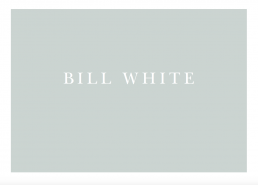Bill White: The Art of the Real Introductory Essay
Bill White: Empathy and Engagement. 2011. Perfect bound book. Full color printing. 2012 ADDY Silver Award.
Bill White is a consummate artist whose paintings imply monumentality, regardless of their actual size. It’s all about the studio coupled with the plein-air experience, the physicality of the paint and the act of painting. In every nuance, his exhibited works emphasize these core values and echo his genuine awareness of life.
Working in oil and oftentimes creating his own paints, White is foremost a colorist. Saturated and brilliant hues pervade his canvases. In “Red Vase” (2011), the frenzied crimson of the vase is soothed by the cool cobalt tones articulated in the table. The viewer’s gaze is fixated dead center on the canvas by the color’s corporeality and is assuaged by the blues mirrored throughout the composition by way of the rendered screen and echoed by the tonalities of the late afternoon light. Color Field artist Jules Olitski sums up the power of color in painting; “Painting is made from the inside out. I think of painting as possessed by a structure… born of the flow of color feeling. Color in color is felt at any and every place of the pictorial organization.”1 Color is a major agent in White’s pictorial arsenal. In his paintings, color functions as an intrinsically powerful structure; it is a conduit uniting other principle elements—scale, light, space and the fixed moment. In his “Downtown Rooftops I” (2011), White’s brilliantly saturated color palette informs a uniquely attenuated skyscape; one would struggle to comprehend its subject devoid of color.
In 1883, French writer and poet Charles Baudelaire wrote passionately of the need for painters to abstain from the academic traditions of the past. He challenged them instead to seek out the beauty in the experience of the everyday. He implored his fellow artists to shift their attention to their own time: “the pleasure we derive from the representation of the present is due not only to the beauty with which it can be invested, but also to its essential quality of being present.”2 A century and a half later, White leads the pack of artists who understands yet chooses to forgo the modernist traditions of non-objective abstraction. Focusing his aesthetic strategy and values of contemporary painting by working from life, White’s work becomes autobiographical in nature and embraces the personality of our time. In “Yellow Reflection” (2011), White captures the character of the studio. We feel but do not perceive his presence, which then gives us the agency to step into the composition. The objects—a table holding a bowl of fruit, a chair sitting on a rug, positioned in front of a window—are ordinary yet abundantly rendered, echoing a grandeur that hearkens back to earlier European painting traditions.
Unlike photo-derived work, White’s paintings eschew artifice and he builds form from actuality. His presence is integral to their making. Lucien Freud once commented to art critic Robert Hughes “I could never put anything in a picture that wasn’t actually there in front of me. That would be a pointless lie, a mere bit of artfulness.” 3 In “Studio Light Suite” (1993), White captures the trail of shifting light and its residual shadows over a myriad of details present in twelve individual paintings grouped in a grid. In documenting the actual passage of time as translated by light, he activates the viewer’s interaction with the work. The paintings are a bittersweet homage to the notion of “memento mori,” reminding us of life’s impermanence. Bill White’s paintings are unabashedly honest testaments to his surroundings. Focusing on perceptual relationships mediated with highly evocative fine-tuned color, his works speak of the ever-evolving tradition of painting from the real.
1 Olitski, Jules. “Painting in Color,” Artforum, January 1967. “American Artists on
Art from 1940 to 1980.” Edited by Ellen H. Johnson (New York: Harper and Row Publishers) 50.
2 Baudelaire, Charles, “The Painter of Modern Life and Other Essays.” Translated and edited by Jonathan Manye (London. Phaidon Press, 1964) 1.
3 Hughes, Robert, “Lucien Freud paintings? (London. Thames & Hudson Ltd.,



